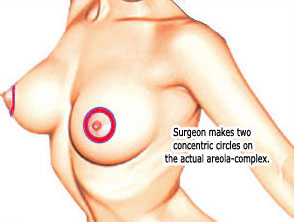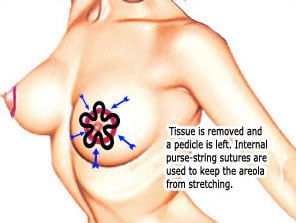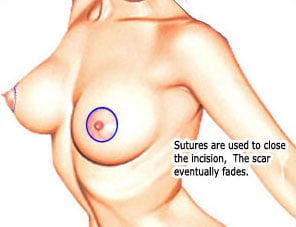
Nipple / areola reduction surgery is a speciality of Dr. Michael Yoo, providing women and men with symmetrical and aesthetically proportionate nipples/areolas.
Contents
What is Nipple/Areola Reduction?
So much attention is placed on breast enhancing procedures such as breast augmentation or breast lift, that it is often overlooked that simply addressing the nipple/areola can create a more aesthetically pleasing breast.

The nipple is the small projection located in the center of the breast, and the areola is the pigmented region around the nipple. The Nipple Areola Complex or NAC has a central role in breast aesthetics. The size, shape, location, positioning and direction vary from person to person, which makes this surgery customizable to each individual.
Sometimes correcting large nipples, puffy areolas or correcting both is all a patient needs to improve the appearance of the breasts. These are actually very common occurrences in both women and men, and can appear on one or both sides. These conditions can be due to genetics, hormones, aging or trauma. Patients may decide to undergo this surgery because they feel self-conscious, while others require the procedure for medical reasons such as difficulty breastfeeding.
Reasons to Get an Areola Reduction
Puffy Areolas
Asymmetrical Areolas
NonCircular Areolas
Reasons to Get a Nipple Reduction
Enlarged Nipples
Inverted Nipples
Lack of Nipples
Ideal Candidates
Ideal candidates for nipple/areola reduction surgery are women and men who are in good health who wish to reduce the size of their nipple and/or areola. This can be done for a reduction in the diameter of the areola or length of the nipple. It is recommended for women to wait until they are done having children because pregnancy and breastfeeding can potentially stretch the areola and/or nipple and reverse the results.
It is important to understand what this surgery can accomplish. It will create a cosmetic reduction in nipple/areola size but it cannot guarantee a boost in self-confidence. More often than not, however, patients experience a significant hike in self-esteem after undergoing nipple/areola reduction with Dr. Michael Yoo.
Consultation
 During your private consultation with nipple/areola reduction specialist Dr. Michael Yoo, you will have the opportunity to explain your aesthetic wishes and desires. Dr. Yoo will perform a detailed examination and determine if this surgery will meet your cosmetic expectations.
During your private consultation with nipple/areola reduction specialist Dr. Michael Yoo, you will have the opportunity to explain your aesthetic wishes and desires. Dr. Yoo will perform a detailed examination and determine if this surgery will meet your cosmetic expectations.
If deemed a good candidate, he will go over all of your options with you, including surgical techniques and ancillary procedures. He will discuss the process in detail from preoperative preparation to recovery.
The Procedure
Nipple and/or areola surgery is performed under local anesthesia on an outpatient basis. There are standard techniques Dr. Yoo utilizes to perform nipple and/or areola reductions, however since every patient is different and has different desires, each patient receives a highly customized technique based on these standard methods.
Nipple/areola reduction surgery typically takes approximately an hour when not performed with ancillary procedures.
During your nipple reduction surgery, the nipple remains attached to the body and the native blood supply is not disrupted. Based on your anatomy and desired change(s), Dr. Yoo can preserve the milk ducts and thus your ability to breastfeed. Various surgical techniques are used and customized to fit your specific goals and desires. Please note that not every female can breastfeed regardless of whether surgery has been performed or not as there is a genetic component to the ability to breastfeed as well.



For nipple inversion, a small incision is typically made near the base of the nipple to give Dr. Yoo access to the fibers that are pulling the nipple inward. He then releases the tethering fibers, thereby allowing the nipple to face outward, and sutures the incision closed.
For areola reduction, the blood supply and the milk ducts stay intact as well. A purse string suture technique is utilized to give long lasting results. This technique uses 2 circular and concentric incisions around the areola to create the desired size. The “excess” areola skin is removed and the nipple remains untouched. A permanent suture is then used to ‘purse string’ the incision closed creating a long lasting to permanent reduction in size. This technique can have the added benefit of causing a slight breast lift.
Ancillary Procedures
Nipple/areola reduction can be performed as a solo procedure or in conjunction with an ancillary procedure that will complement the results.
Breast Reduction
A breast reduction is a surgical procedure that reduces the size and volume of the breast. This is one of the more popular ancillary procedures chosen to be performed along with your nipple and/or areola reduction so that the breast is aesthetically well proportioned and balanced. The incisions made can be used for both surgeries. Excess breast tissue, skin and areola tissue are reduced to the desired size to create both smaller breasts and smaller nipples/areolas.
Breast Lift
A breast lift is a procedure in which the breasts are surgically lifted to a more youthful position. The nipples may become elongated or the areola stretched due to sagging, so the areola and/or nipples can be reduced to be proportionate with the newly lifted breasts. The breast lift and nipple/areola reduction can be performed with the same incisions, minimizing the amount of scarring. The appropriate amount of tissue and skin is excised to create the desired lift and nipple/areola size.
Breast Augmentation
Breast augmentation combined with nipple and/or areola reduction is a good solution for women who desire larger breasts and smaller nipples/areolas. Both the enlargement of the breasts and the surgical reduction of the nipples/areolas will give the illusion that the nipples/areolas are even smaller.
Gynecomastia
Any of the conditions mentioned above relating to the nipple and/or areola can occur for men as well. The areolas may be overly large or puffy due to enlarged male breasts. Gynecomastia surgery can be performed on men to reduce the size and volume of the breasts, and areola reduction can reduce the puffiness as well.
Recovery

Recovery is fairly brief, however, this varies between patients as the length is dependent on how your body reacts to surgery.
You are able to go home right after surgery, and generally our patients are able to return to work and their daily routine the following day. The incisions are covered with a thin film of antibiotic ointment followed by a small piece of clean gauze. The gauze should be changed at least once daily in order to keep the incisions clean.
Walking regularly is important to prevent blood clots. Some discomfort and bruising during the first week of recovery is normal and can easily be controlled with pain medication. Any resulting scarring will typically blend in with the natural areola border and fade with time.
It is recommended you take it easy for a few weeks, not picking up anything heavier than 15 to 20 pounds for the first 3-4 weeks following surgery unless instructed otherwise. You should also avoid high intensity workouts and sexual activity for a few weeks to ensure your results are not disrupted.
Once healed, patients can enjoy their beautiful results, and increased self-esteem and self-confidence, particularly during intimate encounters. Results of the procedure are permanent, but are still subject to the normal processes of aging and gravity.